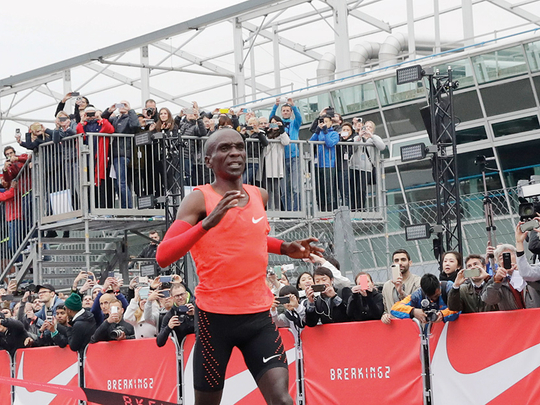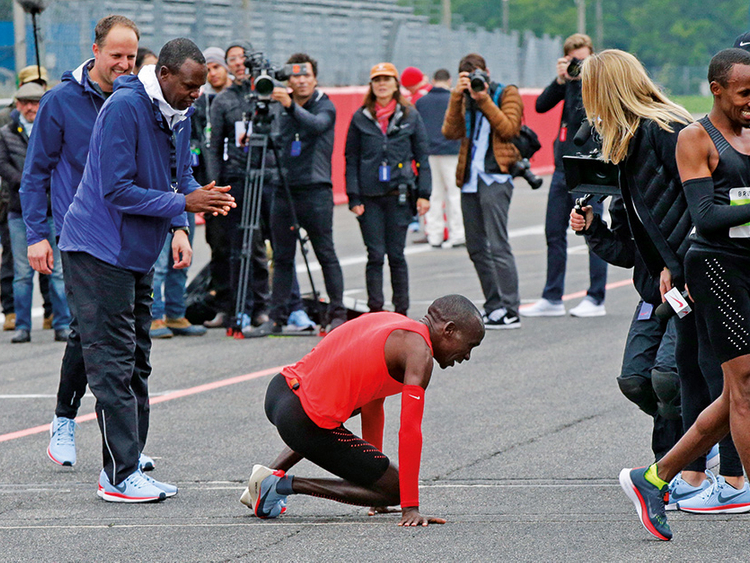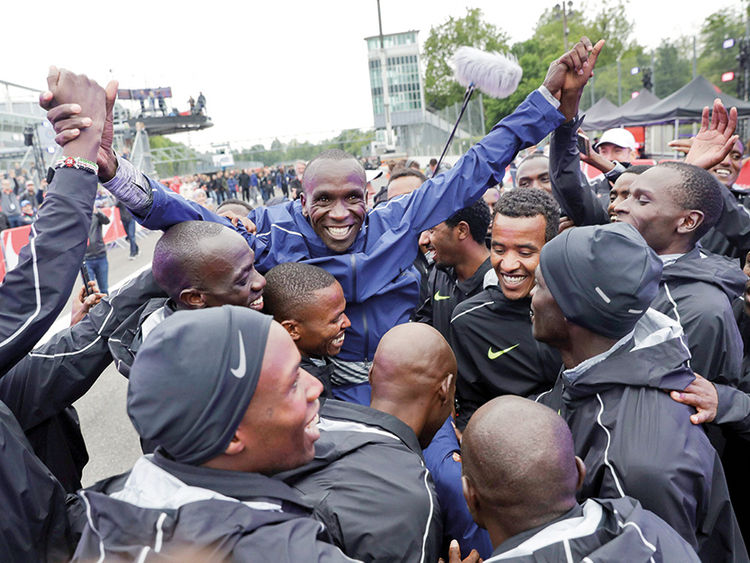
Even in a highly controlled environment, the sub-two-hour marathon remains elusive - just barely.
Eliud Kipchoge of Kenya, 32, the reigning Olympic marathon champion, covered 42.1km in two-hours-25-seconds early Saturday in an extremely managed setting of pacing and drafting on a Formula One racecourse in Monza, Italy, outside Milan.
It was the fastest marathon ever run, more than two-and-a-half minutes quicker than the official world record, 2:02:57, set by Dennis Kimetto of Kenya at the 2014 Berlin Marathon. But Kipchoge’s time will not be ratified for record purposes, mainly because of rules regarding pace-setting.
The attempt, called Breaking2, was as much a Nike marketing play and a laboratory experiment as a sports competition. Even so, Kipchoge shaved a remarkable amount of time off his best official finish: 2:03:05 at the 2016 London Marathon.
Saturday’s attempt was viewed by some critics as a publicity stunt rather than a valid sporting contest, emphasising audacious performance over competition. It came weeks before Nike was set to roll out a new line of running shoes.
“I believe that this has everything to do with shoe sales and very little to do with marathoning,” Kevin Hanson, a top American marathon coach, told Runner’s World this week.
Others were intrigued by the attempt - albeit greatly orchestrated - to redefine the limits of human endurance. There was plenty of curiosity about whether the latest advances in sports science and technology could help a runner break the barrier years or decades earlier than many had predicted.
“In a bigger field, I think it will happen; it increases the odds of more than one person having the day of a lifetime,” said Dr. Michael Joyner, an expert in human performance at the Mayo Clinic who in 1991 predicted that a human could eventually run the marathon as fast as 1:57:58.
While the attempt to break two hours fell short, Joyner said: “Kipchoge, I think, was remarkable. I don’t think this was a failure at all. I’m very encouraged. I think they got in Secretariat zone.”
The race began at 5.45am local time in Italy and consisted of 17.5 laps of 1.49 miles, or 2.4 kilometres, around Monza’s F1 course. Nike chose the course for the area’s cool temperature (about 52 degrees at the start), trees that shield the wind, consistent asphalt surface and lack of sharp turns, as well as a water vapor pressure that would help cool the runners’ bodies through the evaporation of sweat.
A phalanx of pacesetters led Kipchoge and two other elite marathoners around the course. A green line projected onto the road from an electric pace car also showed the pacesetters the precise speed to maintain.
The other two runners participating in the attempt were Zersenay Tadese, 35, of Eritrea, the world-record holder in the half marathon (58:23), who finished on Saturday in 2:06:51; and Lelisa Desisa, 27, of Ethiopia, a two-time winner of the Boston Marathon, who finished in 2:14:10.
The date of the race carried a historical significance in the field of elite running. It came 63 years after Roger Bannister of England broke the four-minute barrier in the mile on May 6, 1954.
The three runners went through 10 kilometers in 28:21, on pace to finish in 1:59:35. Kipchoge, in particular, seemed relaxed. Just before 17km, Desisa fell off the blistering pace. By halfway, Tadese had also dropped out.
Kipchoge, who had won seven of the eight marathons he had entered, appeared to have run the first half in just under 60 minutes. He was left alone, on a sub-two-hour pace, six pacemakers shielding him. After reaching 30 kilometres in 1:25:20, he had slowed slightly but remained on pace to run exactly two hours.
By 35 kilometres, Kipchoge had fallen 6 seconds off his target time. He was running faster than any human had for that distance, but he could not maintain the pace of 4:34 per mile (1.6km) needed to run a marathon in 1:59:59. After 39.4km, some strain on his face, Kipchoge dropped 19 seconds beyond his desired finishing time.
Nike had acknowledged long before Saturday’s record attempt that it would not be considered for a world record. The run did not adhere to several rules required for validation by track and field’s world governing body, the International Association of Athletics Federations (IAAF).
Ross Tucker, a prominent South African sports scientist, theorised on his Twitter account that Kipchoge could run 2:01:10 to 2:01:30 in an official marathon. He said he hoped that Kipchoge would run the flat course in Berlin in the autumn while still in top form because “he can’t have too many more races like this in him.”
A group of 30 pacesetters, in a triangular formation behind the pace car to help reduce wind resistance, alternated during the run to remain fresh. This contravened regulations that require all so-called rabbits to start a race at the beginning. (It was unclear from watching online whether the time clock atop the pace car also helped block the wind to some degree.)
The runners were also provided customised carbohydrate fluids by helpers riding on bikes so they did not have to slow down, which is not permitted in major marathon competitions.
Kipchoge, Desisa and Tadese wore customised lightweight shoes with a carbon-fibre plate that some scientists believed gave the runners an unfair advantage because it effectively acted as a spring.
But the rules about shoe design set forward by the IAAF are extremely vague, and Nike says its shoes are in compliance. The customised shoe worn on Saturday reduces by 4 per cent the energy needed to run at a given speed and helps to reduce fatigue, the company said.
The Breaking2 attempt came at a fraught time for track and field and distance running, with doping scandals plaguing the sport and international officials considering whether to discard all world records set before 2005.
Questions were raised about whether the three runners had undergone any enhanced anti-doping measures before Saturday’s race. Nike said only that Kipchoge, Desisa and Tadesa had been tested regularly according to standard IAAF protocols.














